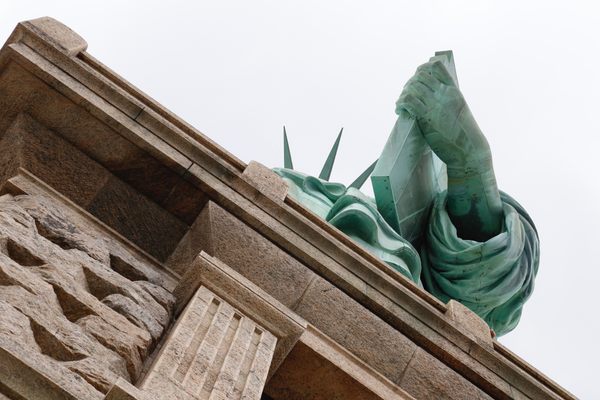Food for the Ages: 7 Historical NYC Dishes You Can Still Order Today
Travel through time—and all five boroughs—for these time-tested classics.
New York has always been a hungry city, with locals and visitors alike constantly searching for the next best bite. For 19th-century workers, oyster bars provided a cheap snack similar to today’s dollar pizza slice. Meanwhile, members of New York’s elite once toasted each other over terrapin (or turtle) soup at fine hotel restaurants.
But times and tastes change constantly, especially in a global food destination like New York. To see just how much, take a glimpse into the New York Public Library’s massive collection of historical online menus, many originally gathered by Miss Frank E. Buttolph in the early 20th century. One menu for a fine dinner served at the Fifth Avenue Hotel in 1882 features terrapin soup and canvas-back duck, a wild North American bird popular on upper-class menus until it became scarce from overhunting. (The menu itself was printed on pink silk.)

Other foods on these vintage menus will be more familiar to modern New Yorkers. In April of 1904, the Mann Fang Lowe Chinese restaurant, at 3 Pell Street, offered chow mein, chicken with mushrooms, and roast pork.
The Mann Fang Lowe is long gone, as are most restaurants with menus in the New York Public Library’s archives. But some are still going strong, keeping the things that made them special while adapting to the times. Gallaghers Steakhouse still proudly serves up steaks and speakeasy history today, while Serendipity 3 continues to offer outrageous desserts in a quirky setting. These institutions even made some history of their own together by participating in the very first New York City Restaurant Week back in 1992, when well-known restaurants across the city offered three-course lunches for the price of $19.92. The first Restaurant Week was such a hit that it inspired imitations across the country, and in New York, it became such a phenomenon that it’s now held twice a year.
In a sense, Restaurant Week and the historical menu collection are two sides of the same coin: the ongoing effort to highlight the fascinating blend of culinary experiences on offer across every borough of New York City. And if you’re looking to take a historical view on your next culinary adventure, these dishes are the perfect place to start.

“The Other Soup” at Gallaghers Steakhouse — Manhattan
While today it serves steak and oysters entirely aboveboard, Gallaghers, located just steps away from rip-roaring Broadway and Times Square, originally got its start as a speakeasy in 1927. In fact, the restaurant still pays tribute to those years with a certain unorderable menu item. Just try asking for “The Other Soup,” listed at market price. There is, in fact, no “other soup” on offer at Gallaghers, other than French onion or clam chowder; the name was code for alcohol during Prohibition. Can this menu item be used to sneak in a cocktail on your business lunch expense account? You’ll have to let us know.

“She-Crab Soup” at Gage & Tollner — Brooklyn
In 1879, Gage & Tollner first opened in Brooklyn, offering oysters and a menu of Victorian-era delights to its famous guests. Its current location, where the restaurant set up shop in 1892, is a Gilded-Age fantasia of mirrors and columns. The restaurant became a Brooklyn icon, and, in 1975, the interior was designated as a landmark by the New York Landmarks Commission. But tastes and the surrounding neighborhood changed, and the restaurant closed in 2004. Though the interiors were preserved, the space was occupied by various discount shops and fast-food chains for decades.
Yet Gage & Tollner celebrated a glorious rebirth in 2021, with its new owners fixing up the place and bringing many classic dishes back on the menu. One standout is the she-crab soup introduced by Southern chef Edna Lewis, who ran the kitchen from 1988 to 1992. The soup comes with a boat of sherry to pour atop the hot, crab-laced broth.

“Haymaker’s Punch” at Neir’s Tavern — Queens
In nearly continuous operation since 1829, Neir’s Tavern is one of the oldest bars in the country. The bar, however, hasn’t been frozen in time. Though it has a long and fascinating history, it’s still a neighborhood pub with chicken tenders and familiar beers on the menu. But also on the menu is a drink that was popular back when the bar first opened in 1829.
Haymaker’s punch is a sweet-and-sour, vinegar-based beverage that was served as a kind of energy drink for farmers working for hours out in the sun. Neir’s Tavern offers a modern version made with molasses and apple cider vinegar. It comes with or without a shot of rum.

“Frrrozen Hot Chocolate” at Serendipity 3 — Manhattan
This over-the-top dessert palace opened in 1954 as a quirky blend of antique store and café. Though its menu offers much in the way of actual food, from foot-long hot dogs to nachos, the Frrrozen Hot Chocolate has been the main attraction for generations of New Yorkers and tourists. The oxymoronic nature of a hot drink served cold and the novelty of drinking a blend of 14 different types of cocoa from a huge bowl-like glass made it famous, so much so that Serendipity 3 proudly boasts that Jackie Kennedy once asked for the recipe and was turned down. The restaurant mixes it up these days by offering all kinds of variations on the original drink, with ingredients ranging from peanut butter to Fruity Pebbles.

“Charlotte Russe” at Holtermann’s Bakery — Staten Island
This old-school bakery serves the last vestige of what was once a beloved treat across all of New York City. The Charlotte Russe consists of sponge cake, cream, and jam, served up in an ingenious single-serve container that functions like a Push Pop, making it easy to scarf down every scrap. These handheld cakes were once especially beloved in Brooklyn, but Holtermann’s in Staten Island might be the only holdout still making them today.

“Bagna Cauda” at Barbetta — Manhattan
This venerable Italian restaurant is one of the oldest in New York, dating back to 1906. Barbetta claims to have introduced staples such as risotto, polenta, and sun-dried tomatoes into the American pantry, as well as regional dishes such as bagna cauda, a hot dip of garlic, anchovies, olive oil, and wine. In fact, the current Barbetta menu also offers a glimpse into the past. Each dish is listed alongside a year, denoting when the restaurant first began serving it. Guests can dine through the decades, sampling roast peppers bagna cauda-style (1962), linguine al pesto (1914), and panna cotta (1984).

“The Sausage Chandelier” at Calabria Pork Store — The Bronx
Arthur Avenue is lined with food shops and restaurants that have been open for generations, serving the community and earning the area the title of New York’s “real” Little Italy. There’s lots to see and eat, but for an awe-inspiring sight, head over to the Calabria Pork Store, home of the “Sausage Chandelier.” The ceiling bristles with bundles of cured meat hanging overhead. The store got its start in 1973 as a salumeria focusing on the traditional meats of Calabria. The store is still dishing out its famous soppressata and sausages today, and you can also take home a sandwich instead of buying meat to make your own.
In honor of New York City’s 400th anniversary in 2025 and the United States’s 250th in 2026, NYC Tourism has launched Founded By NYC, a campaign that commemorates the five boroughs’s inspiring achievements and legacy of groundbreaking innovation. Find ways to celebrate the city that’s always making history at foundedbynyc.com.






Follow us on Twitter to get the latest on the world's hidden wonders.
Like us on Facebook to get the latest on the world's hidden wonders.
Follow us on Twitter Like us on Facebook